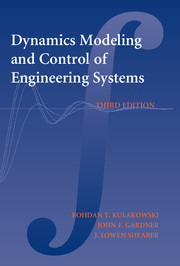Book contents
- Frontmatter
- Contents
- Preface
- Dynamic Modeling and Control of Engineering Systems
- 1 INTRODUCTION
- 2 MECHANICAL SYSTEMS
- 3 MATHEMATICAL MODELS
- 4 ANALYTICAL SOLUTIONS OF SYSTEM INPUT–OUTPUT EQUATIONS
- 5 NUMERICAL SOLUTIONS OF ORDINARY DIFFERENTIAL EQUATIONS
- 6 SIMULATION OF DYNAMIC SYSTEMS
- 7 ELECTRICAL SYSTEMS
- 8 THERMAL SYSTEMS
- 9 FLUID SYSTEMS
- 10 MIXED SYSTEMS
- 11 SYSTEM TRANSFER FUNCTIONS
- 12 FREQUENCY ANALYSIS
- 13 CLOSED-LOOP SYSTEMS AND SYSTEM STABILITY
- 14 CONTROL SYSTEMS
- 15 ANALYSIS OF DISCRETE-TIME SYSTEMS
- 16 DIGITAL CONTROL SYSTEMS
- APPENDIX 1 Fourier Series and the Fourier Transform
- APPENDIX 2 Laplace Transforms
- APPENDIX 3 MATLAB Tutorial
- APPENDIX 4 Simulink Tutorial
- Index
5 - NUMERICAL SOLUTIONS OF ORDINARY DIFFERENTIAL EQUATIONS
Published online by Cambridge University Press: 05 June 2012
- Frontmatter
- Contents
- Preface
- Dynamic Modeling and Control of Engineering Systems
- 1 INTRODUCTION
- 2 MECHANICAL SYSTEMS
- 3 MATHEMATICAL MODELS
- 4 ANALYTICAL SOLUTIONS OF SYSTEM INPUT–OUTPUT EQUATIONS
- 5 NUMERICAL SOLUTIONS OF ORDINARY DIFFERENTIAL EQUATIONS
- 6 SIMULATION OF DYNAMIC SYSTEMS
- 7 ELECTRICAL SYSTEMS
- 8 THERMAL SYSTEMS
- 9 FLUID SYSTEMS
- 10 MIXED SYSTEMS
- 11 SYSTEM TRANSFER FUNCTIONS
- 12 FREQUENCY ANALYSIS
- 13 CLOSED-LOOP SYSTEMS AND SYSTEM STABILITY
- 14 CONTROL SYSTEMS
- 15 ANALYSIS OF DISCRETE-TIME SYSTEMS
- 16 DIGITAL CONTROL SYSTEMS
- APPENDIX 1 Fourier Series and the Fourier Transform
- APPENDIX 2 Laplace Transforms
- APPENDIX 3 MATLAB Tutorial
- APPENDIX 4 Simulink Tutorial
- Index
Summary
LEARNING OBJECTIVES FOR THIS CHAPTER
5–1 To explain the fundamental principle of numerical integration as a finite sum of approximate areas.
5–2 To implement simple numerical integration methods by use of MATLAB or a similar computing platform.
5–3 To articulate the advantages of higher-order approximation methods and adaptive-step-size algorithms as more accurate and more efficient methods for integration.
5–4 To recognize numerically stiff systems and use methods that alleviate the difficulties that they present in computer solutions.
INTRODUCTION
For centuries, engineers and scientists have sought help from calculating machines of all kinds in solving mathematical equations that model dynamic systems. A digital computer, the most recent version of the calculating machine, has come a long way from the more than 5000-year-old Babylonian abacus. Most engineers would probably prefer a computer to an abacus because of its superior computational power, but both devices are capable of performing only those tasks that engineers already know how to perform but either choose not to do, for some reason, or cannot do because of lack of sufficient speed or memory or both. Despite today's fascination with computers, it is important to remember that they can do only what they are programmed to do within their vast yet finite performance limits.
Generally speaking, correctness of computer results depends on two conditions: the correctness of the formulation of the problem and the computational capability of the computer to solve it. It does not seem widely recognized how often at least one of these conditions is not met, leading to worthless computer results.
- Type
- Chapter
- Information
- Dynamic Modeling and Control of Engineering Systems , pp. 120 - 140Publisher: Cambridge University PressPrint publication year: 2007



